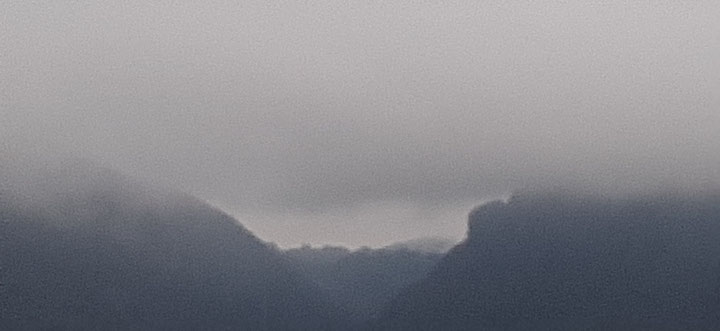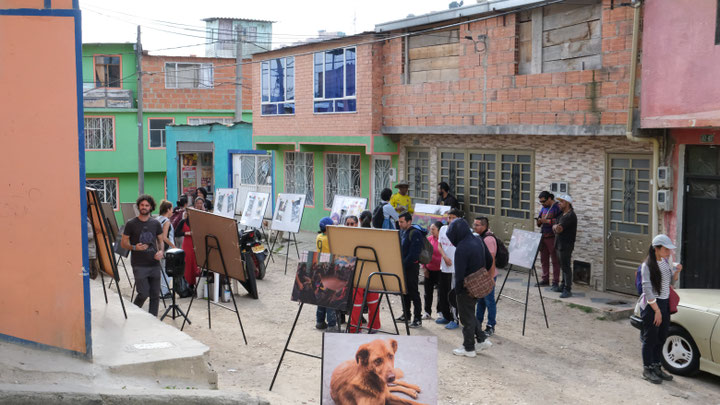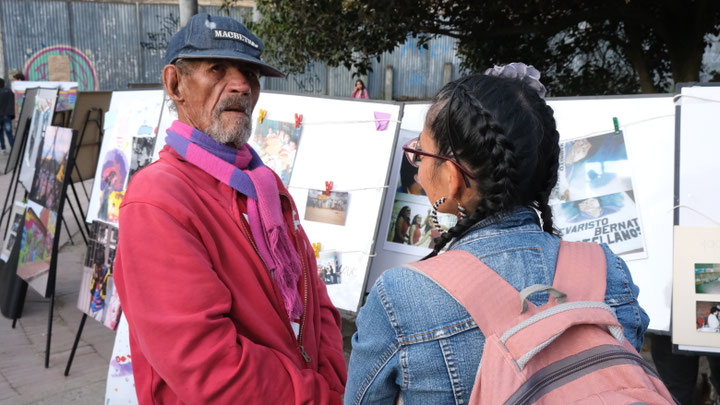Issue 3/2023 - Queer Postsocialist
Relationality as Resistance and Care in the Spaces Between the Mountains
When one speaks about the mountains from a relational ontology perspective, it is not only about geological beings. It’s about all the beings that inhabit the mountains from a social, spiritual, and ecological point of view. These ideas of relational beings in multiplicity are part of the indigenous ontologies of Abya Yala1 and find their expression in the concept of body-territory. Body-territory comes from indigenous philosophies and has been mainly used by the community- and indigenous-feminist groups of Abya Yala to conceptualize a profound link between bodies and the territories they inhabit. In this way, a division between beings and the space they occupy is inconceivable. The relational ontology finds its epistemological expression in Abya Yala in the concept of feeling-thinking. This concept entails a way of relating to the world in which thinking is not exclusively logical but, on the contrary, it is also generated from feeling; in other words, it is “thinking from the heart.”2
In the history of Colombia, the mountains have often been spaces of resistance. Already during the time of the Spanish colony, they welcomed and embraced indigenous peoples who were displaced from territories that were considered more suitable for cultivation and other economic activities by European colonizers. In the last century, the mountains became places of habitation and shelters for groups of people who could not find housing elsewhere or who, due to conflicts of violence or political prosecutions, had to flee.
In times of global capitalism and migratory movements, the mountains as bodies-territories have started traveling too becoming part of the global chains of capital production. They are excavated for minerals that are speculated in the stock markets and then found in cell phones or computers. The bodies-mountains travel when their peoples are forced to migrate for work in urban centers’ factories or do the poorly paid care work for the bodies-territories in the global north.
Feeling-thinking with the mountains, I have carried out a participatory art project Las Manos que Empujan el Viento [The Hands that Push the Wind] with a collective of women madres comunitarias3 called Asodenfa in the Potosi neighborhood of Bogotá, Colombia. The Potosi neighborhood has been built by displaced people since the late 1970s on the slopes of the mountain Cerro Seco, south of Bogotá. The mountain’s original name in Muysc Cubun [Muisca Language]4 is Fina Gua, meaning “a wind mountain.” As a body-territory, Fina Gua is a traveling mountain. Firstly, it has been a site for extracting building materials to construct the metropolis – Bogotá. Secondly, it is also a place from where the labor force comes – the working-class people who build and maintain the metropolis. From its beginning the Potosi neighbourhood has been a place of remarkable socialist struggles for survival and self-governance. Formed in social and environmental collectives, its inhabitants have made these mountains their home and successfully defended it from mining extractivism and indiscriminate urbanization. In that way, they have become one being with the mountain: the community living on Fina Gua is a community-mountain.
My own body-mountain’s journey started at first from a periphery of Colombia to Bogotá, then from there to the global north. It’s been a journey of fractures that makes me a fractured body-mountain. Silvia Rivera Cusicanqui calls this kind of fractured being based on the Aymara cosmology a Wut Walanti refering to an object that is irreparably broken and simultaneously forms into something whole, in some cases new in itself. This fragmentary condition generates a unique charm and value previously unknown.5
Taking the concept of Wut Walanti into account, I feel-think the spaces between the mountains as multiple metaphors. On one hand, the in-between spaces are geological ruptures of the mountains, that symbolize all fractures in the human and non-human beings produced by the capitalist, patriarchal and colonial powers. They are the spaces where the beings dwelling in them and their voices are labeled as non-existent and silenced. On the other hand, they are the places of relationality despite the produced ruptures and inflicted fractures. They are the places where the clouds touch the mountains, and where the birds travel from one scarp to another. Moreover, I also understand them as the abysm through which the bodies- and communities-mountains travel like the wind moving from one place to another through apparent emptiness.
As a migrant artist, who embodies different simultaneous positionalities of in-betweenness, and is not part of the communities-mountains, I inhabit these spaces between the mountains. It is from there that I establish relations with the communities-mountains of Fina Gua. I propose to think these in-between spaces as queer spaces where what is branded as non-being can emerge in non-binary forms that challenge the established limits and norms. These queer spaces between the mountains have the potential to defy hegemonic roles of gender identities with their oppressive structures that foment macho violence, a widespread tragedy in Abya Yala.
The artistic-relational project that we developed together with Asodenfa collective was a meeting point where we found a possibility to listen to one another, and to other voices of migrant-mountains. It was a process of creating relationally in those in-between spaces, despite our differences in gender, class, and available roles. We practiced collective listening from the heart as a methodology of relationality through long group dialogues, and walks in the mountains while recording ambient surrounding sounds. As a result of these deep listening processes, a two-part podcast was created: Las Manos que Empujan el Viento [The Hands that Push the Wind]. The title was part of a song we composed collectively for the podcasts. The song talks about the struggles of the women in the Potosi neighborhood during the urbanization of the mountain in the 1970-80s. It recalls a memory of the laborious handwork with simple materials in constructing houses despite strong winds. The hands’ metaphor also refers to the hard labor of the women who sustain the whole community through their care work.
In our podcasts, we covered different topics and themes. The women talked about their migration experiences and the causes that forced them to relocate to the mountains. They pointed out that one of the main reasons for the relocation was a lack of habitable places in the city: they couldn’t afford high rents of Bogotá due to the unsteady income. Yet another topic in the podcast was about their women’s struggle to be recognized as political actors in a highly macho environment of the Potosi neighborhood. In our recorded conversations, we walked back in their memories to recall and honor their resistance and envision what lies ahead of us.
We presented these podcasts for the first time in the streets of Potosi as part of the Evaristo Bernate Castellanos Festival that has been held since 2001. Evaristo was a radical socialist and one of the promoters of communities’ self-organization and resistance in the Potosi neighborhood who played a crucial role in establishing the Asodenfa collective in the 1980s. He was assassinated in 1991 due to his political agenda and social work.
In the wake of the practice of listening directly to the voices of the systematically marginalized communities-mountains, I would like to give the floor in this article to voices of Adriana Gutierrez Ayala and Edit Gutierrez Ayala of the Asodenfa collective, who together with Maria Isabel Zuluaga of Colectivo Direfentes, another collective of the Potosi neighbourhood of Bogotá’s mountains, wrote a manifest about the community work behind the Festival’s organization. Through this practice of feeling-thinking-listening-reading, we extend and expand the chains of our relationalities and relations towards other bodies- and communities-territories.
Manifest for Life and Memory
Four decades, a road traveled that has been a constant deconstruction of social processes carried out in the Potosi neighborhood in Ciudad Bolivar (Bogotá-Colombia). Each phase comes with its own dynamics and leadership; however, in this journey of unity, hope, and resistance we can claim we are the sum of conquered struggles of past generations, of present experiences of organizations raising their voices against injustice and seeking to build something different to achieve a better life; also the sum of future struggles that have not yet come to fruition. These struggles have played out in different ways and with different emotions, where cultural dialogues and memory converge in a scenario such as the Evaristo Bernate Castellanos Festival, which commemorates the historical legacy of the teacher, the comrade, who gave his life to dignify the lives of others. A dreaming human being who brought education to one of the most remote places on the outskirts of Bogota, leaving a legacy that transformed and continues to change lives without time being an impediment. On May 11, 1991 bullets silenced his voice, his ideals, however, are still alive in the community as echoes in time. Since the onset, the festival has established four fundamental principles with a social and community approach, and a forward-looking view of Potosi:
Pedagogical principle: from the point of view of organizational and teaching practices, Popular Education has been the strategy to open possibilities for life, transformation of realities and social fabric in a territory that historically has been marginalized and segregated. Starting point is the idea that we are subjects with the capacity to make free and responsible decisions to write our history and transform society. Cultural principle: Our territory requires more reflective, critical, and creative human beings. It is in this context that art plays an influential role to re-signify realities. We need to build thoughts and projects with others; communicate in different contexts using diverse expressive resources; solve situations which present dilemmas from active and sensitive listening that allows us to understand, recognize and meet each despite our difference, using the communicative and convening power that art has. Environmental principle: exercises of environmental memory have been developed recognizing other beings that keep us company in our mountain Cerro Seco. However, the natural and human ecosystems have been victims of, as well as responsible for, mining exploitation, neglect of the state, lack of interest in knowledge, as well as actions carried out by most of the territory’s inhabitants. However, in this long history some groups have been working with hope and certainty that the relationship with the ecosystem, as well as a more caring approach will be transformed thanks to certain activities and constant togetherness. Research principle: We found a varied and valuable documentary archive (books, magazines, documentaries, photographic archive, and systematization of the territory’s biodiversity) exhibited in different formats during the 2023 Festival as evidence of a grassroots-based, emergent research process.
Since none of us is a finished being, possibilities remain open in this continuous community construction. Thus, each attempt to meet, remember, learn, and celebrate a new version of the festival requires solving essential questions that allow unleashing answers to the transformations of the collectivities, of the ecosystems, and their ways of making and celebrating themselves. We still formulate questions such as: how to reinvent the neighborhood through the festival? how to reinvent our relationship with nature and territory? how do community actions take place? and what is a community, if not those actions motivated by the common desire to collaborate from the open possibilities of each being? And finally, how can we involve the neighbor who only looks out the window?
1 Abya Yala is the term used by numerous indigenous groups in the American Continent to refer to the whole “American” territory. See: F. Del Pópolo, Los pueblos indígenas en América (Abya Yala): desafíos para la igualdad en la diversidad. Santiago de Chile 2017.
2 Sentipensante. (2019, December 15). El pensamiento de Orlando Fals Borda. https://sentipensante.red/.
3 Madres comunitarias [Community mothers] are women’s collectives who have established self-organized, autonomous child care in pseudo-urban and marginalized areas of Colombia since the 1970s.4 The Muisca people are the original inhabitants of Bogotá and adjacent regions.
5 S. Rivera Cusicanqui, Un mundo ch’ixi es posible: Ensayos Desde la Presente Crisis. Buenos Aires 2018, p. 81.


